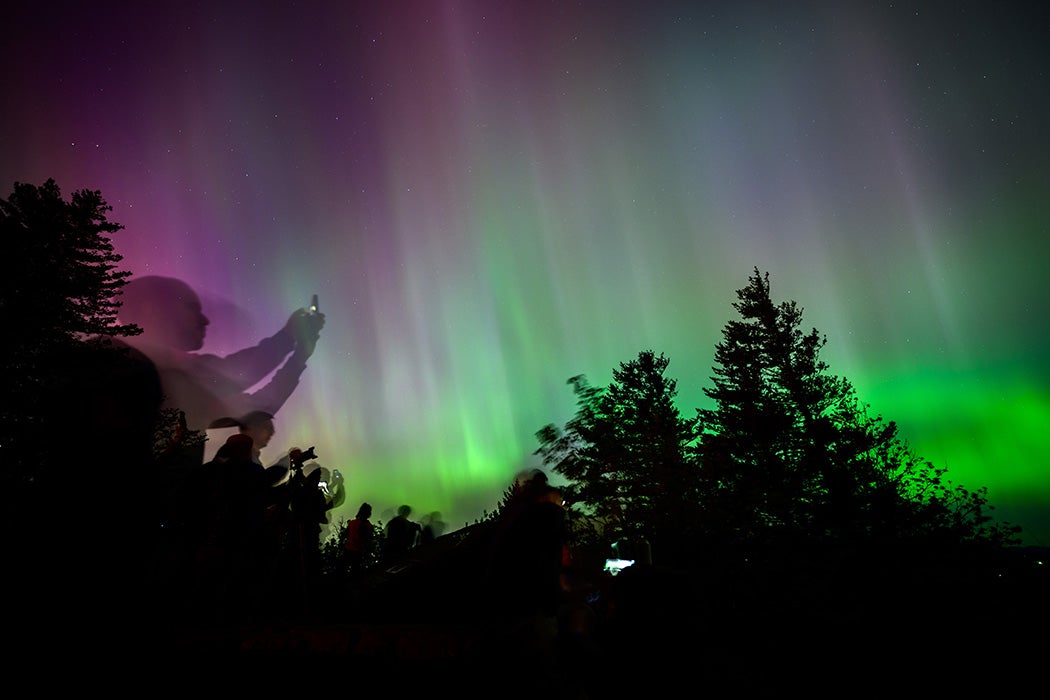Every eleven years or so, the Sun’s magnetic field goes a little crazy and flips, magnetic north becoming south and vice versa. Before this happens, solar activity builds to a maximum, ejecting massive plasma and waves of radiation. We’re near a “solar max” now. These energetic eruptions are a “potentially perilous time for Earth,” disrupting communications and hobbling infrastructure.
On the plus side, a “solar max” can result in spectacular displays of polar lights. In recent weeks, the aurora borealis (northern lights) have been seen as far south as Florida, while the auroral australis (southern lights) have been seen as far north as Queensland, Australia.
An aurora’s curtains of color in the night sky are created by the interaction of the Earth’s magnetosphere and atmosphere with the solar wind. Some of the electrons and protons streaming out from the Sun get caught by the Earth, where they excite or ionize aspects of atmospheric chemistry.
Humans have been bedazzled by the effects for millennia, making up many stories to explain the enigmatic lights. The science of auroras, on the other hand, is of more recent vintage.
Historian of science Helge Kragh writes that auroral research “didn’t constitute a scientific discipline” of its own until half way through the twentieth century. During the early part of the last century, scientists in a variety of disciplines, including astronomy, physics, meteorology, looked to the lights, but funding and institutional support were lacking everywhere but Norway. Kragh tells the story of the understanding of what caused the “auroral green line,” the signature yellowish-green color that dominates the northern lights.
Spectrographs breaks down light into its component parts or colors. Different kinds of astronomical phenomena have different spectrograms, allowing for the deciphering of the elements causing the colors via comparisons with Earth-based experiments. Spectrographic analysis was first applied to auroral light in the late 1860s, but for decades there was a mystery about what caused the green line.
This line or wavelength was first measured by Anders Jonas Ångstrom in 1869. (That wavelength was later codified as 5577 Ångstrom units [Å] or 557.7 nanometers.) But what made it green? The color didn’t match the known spectral emissions of the elements, so some scientists of the late nineteenth and early twentieth centuries postulated that there might be an “unknown auroral gas” in the atmosphere there. This isn’t so far-fetched: helium, second only to hydrogen as the most abundant element in the observable universe, was only isolated in 1895.
Was it this unknown gas, or something more readily known, like nitrogen, krypton, neon, or oxygen? In 1925, some fifty-seven years after Ångstrom discovered it, post-doc Gordon Shrum produced the line in experiments with helium-oxygen mixtures. (Kragh also details how Shrum’s professor, John McLellan, got most of the credit). Others later pinpointed the chemical origins of the green line to oxygen alone. Helium, argon, and neon could all enhance the effect, but it was the way oxygen worked that mattered.
Weekly Newsletter
Shrum’s discovery coincided with the theoretical physics of the day: quantum theory, the precursor to modern quantum mechanics, or the study of the behavior of things at the atomic and subatomic level. The question of why the auroras have a certain dominant color isn’t one of aesthetics but rather speaks to the fundamental building blocks of the universe. The green line is caused by solar particles interacting with the transition of two metastable states of oxygen. (Here’s the detail.) This means that, since the Earth is constantly bathed in the Sun’s effluvia and there’s always oxygen in the atmosphere, the green light is a “permanent feature of the night sky.”
In the absence of a fabulous aurora, however, this green is too faint to seen by the human eye.







